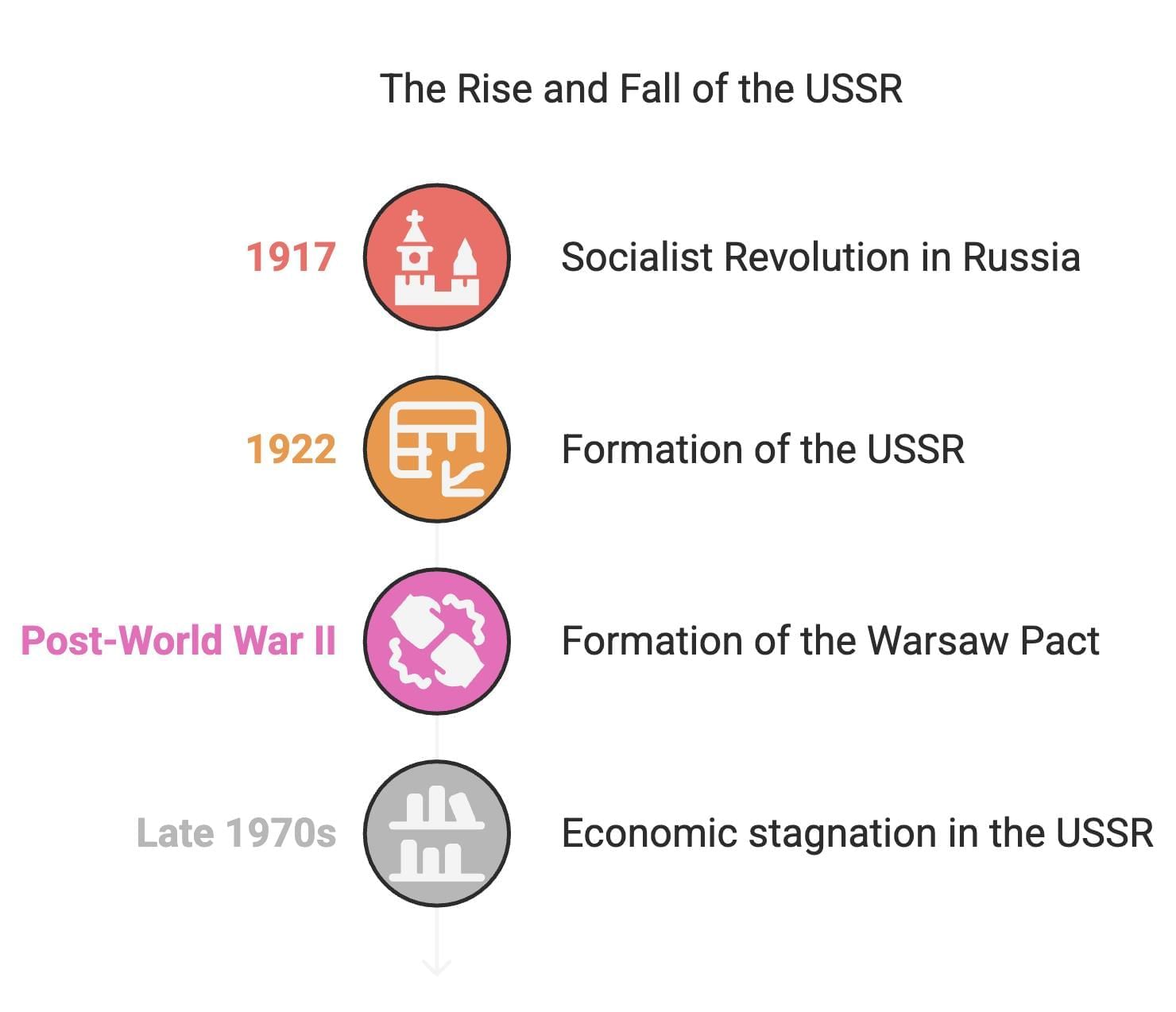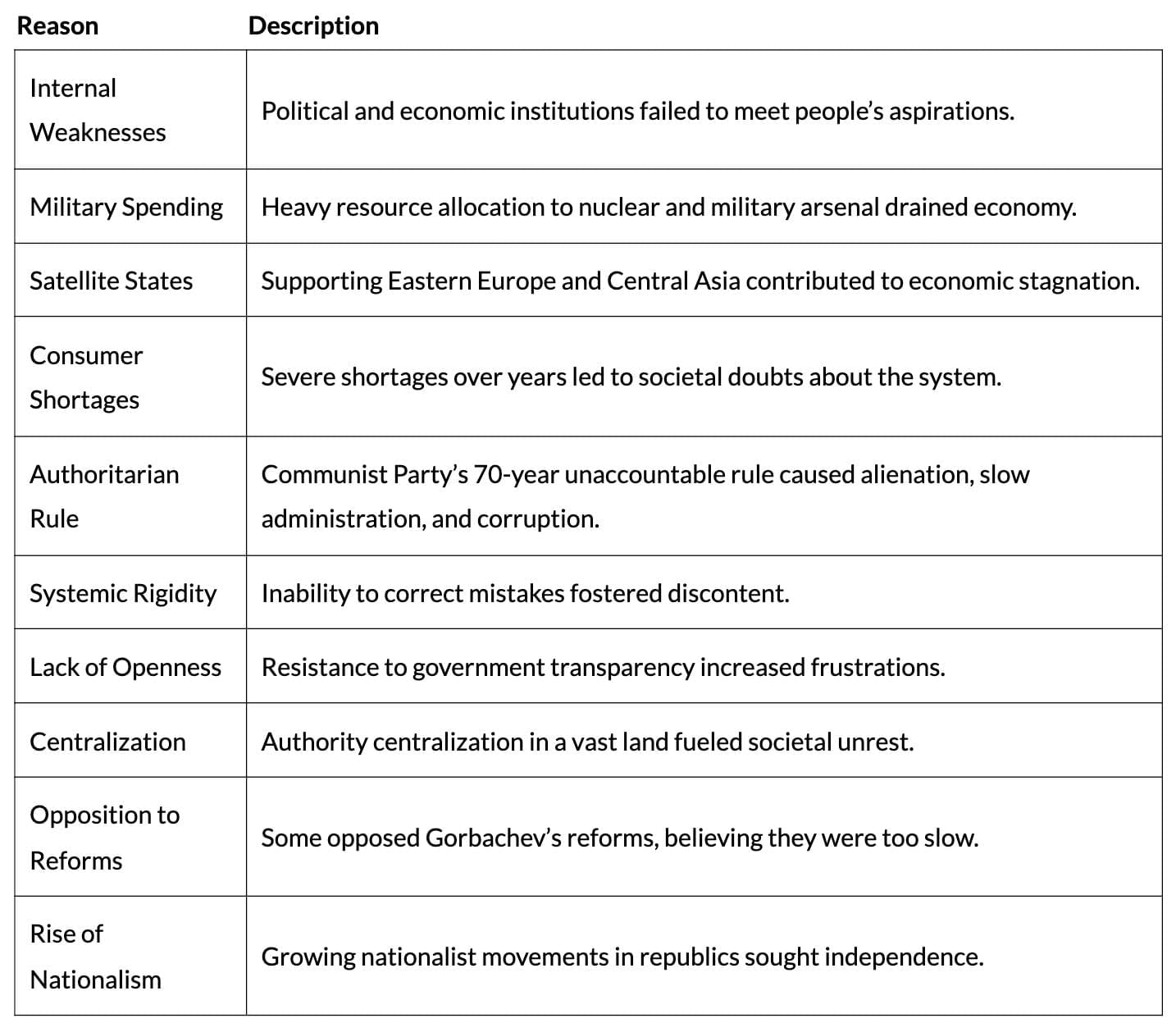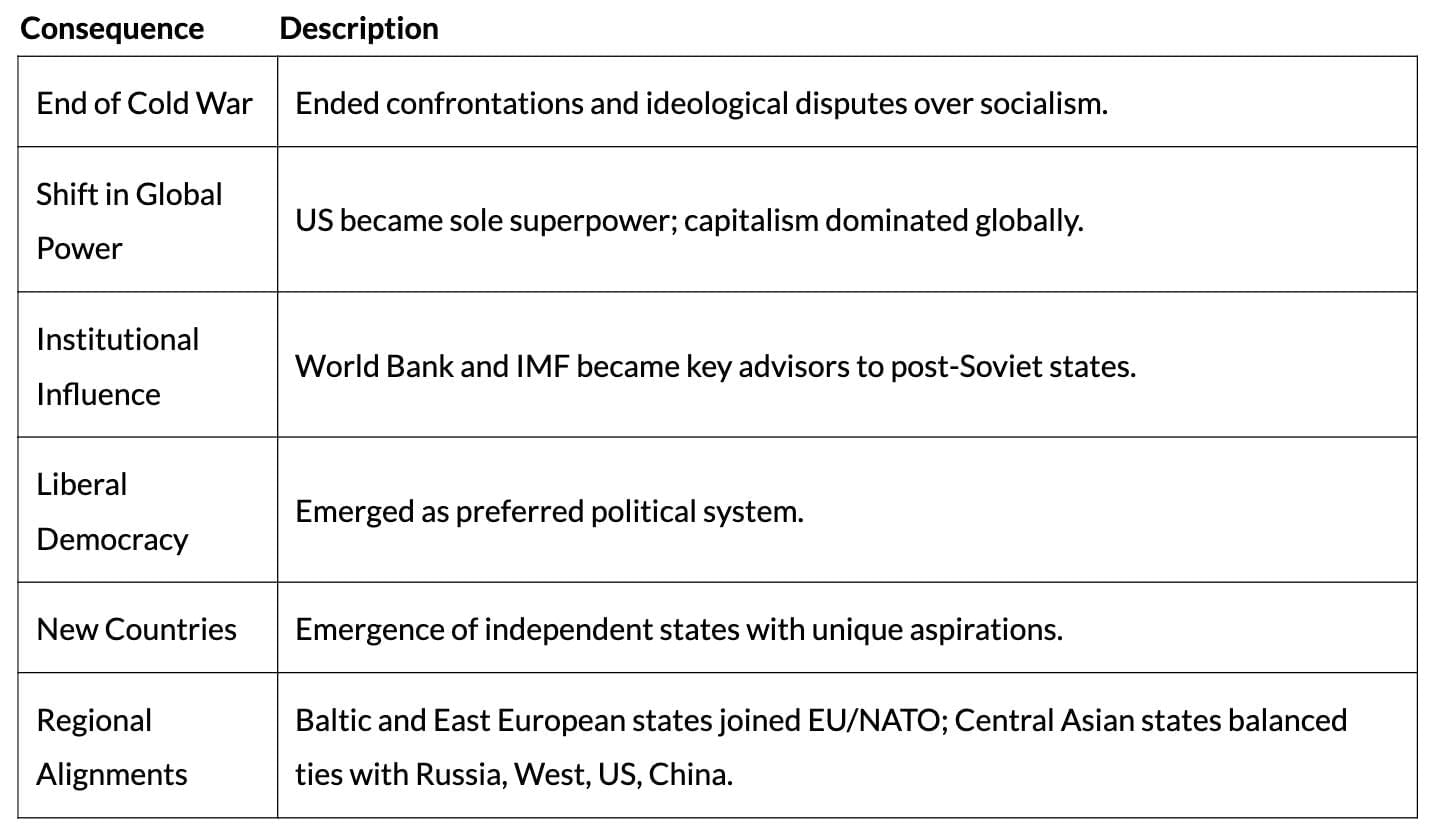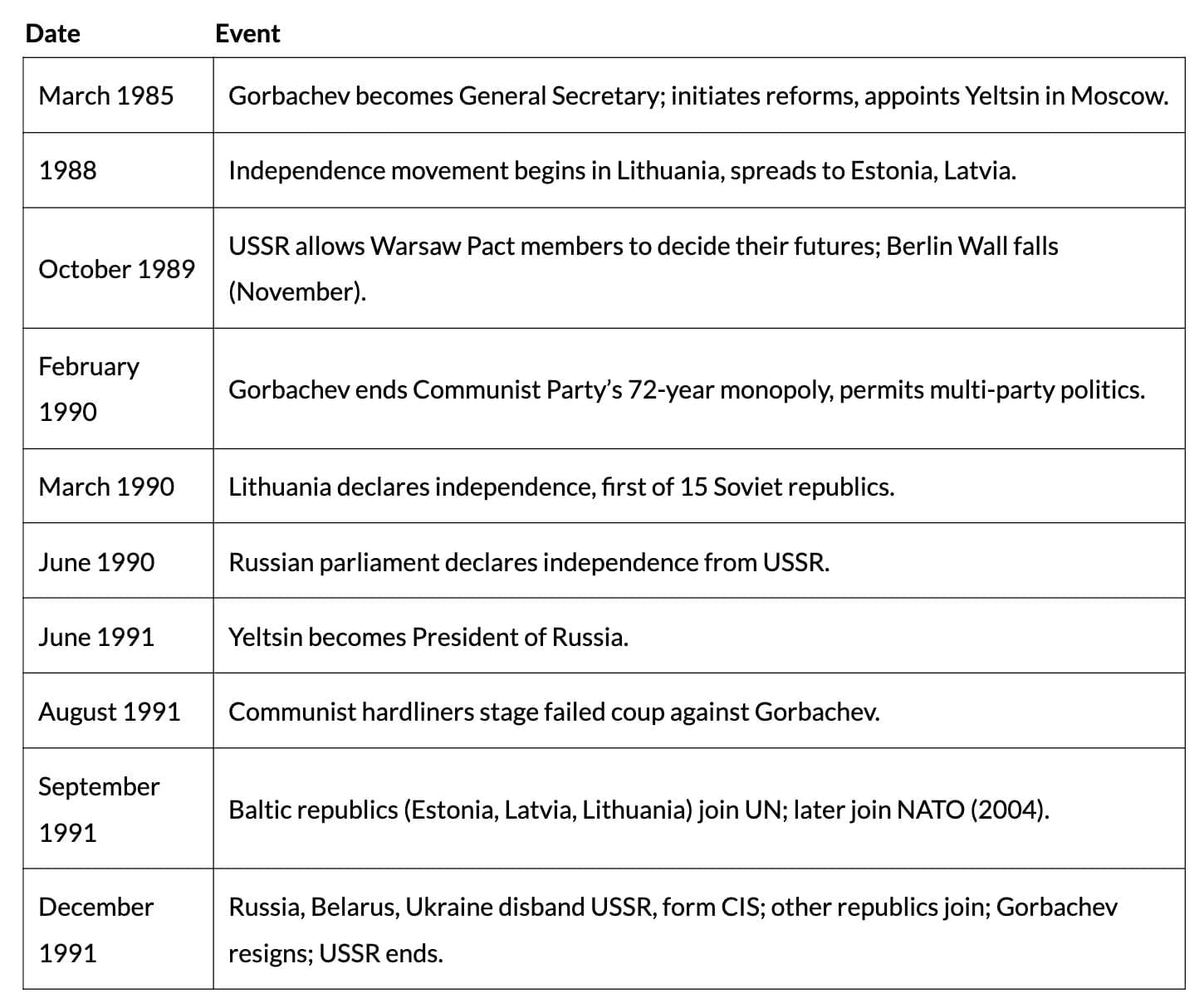Humanities/Arts Exam > Humanities/Arts Notes > Political Science Class 12 > Cheat Sheet: The End of Bipolarity
Cheat Sheet: The End of Bipolarity | Political Science Class 12 - Humanities/Arts PDF Download
What Was the Soviet System?
- Formation: The Union of Soviet Socialist Republics (USSR) emerged after the 1917 socialist revolution in Russia, inspired by socialism and the goal of an egalitarian society, opposing capitalism.
- Political System: Centred on the Communist Party; no other parties or opposition allowed.
- Economy: Planned and state-controlled.
- Post-World War II: Eastern European countries liberated by the Soviet army formed the socialist bloc, united by the Warsaw Pact military alliance.
- Strengths: Ensured minimum living standards, subsidised necessities (health, education, childcare, welfare), and eliminated unemployment.
- Weaknesses: Bureaucratic, authoritarian; lagged behind the West in technology, infrastructure, and meeting political/economic aspirations; economy stagnated by the late 1970s.

Gorbachev and the Disintegration
- Reforms (1985): Mikhail Gorbachev, General Secretary of the Communist Party, initiated reforms to normalise relations with the West, democratise, and reform the Soviet system.
- Unintended Consequences: Reforms exposed system defects; East European countries protested Soviet control; Gorbachev did not intervene, leading to the collapse of the communist regime.
- Coup (1991): Communist Party hardliners attempted a coup against Gorbachev, opposed by people seeking freedom.
- Dissolution (December 1991): Russia, Ukraine, and Belarus, led by Yeltsin, declared the USSR disbanded; adopted capitalism and democracy.
- Russia’s Role: Accepted as the USSR’s successor state, inheriting its UN Security Council seat and international commitments.
Reasons for the Soviet Union Disintegration

Consequences of Disintegration

Shock Therapy in Post-Communist Regimes
- Definition: Transition from authoritarian socialism to democratic capitalism, influenced by the World Bank and the IMF.
- Features: Total shift to capitalism, dismantling Soviet-era structures, breaking trade alliances among Soviet bloc countries.
- Variations: Differed in intensity and speed across former Soviet states.
Consequences

Tensions and Conflicts
- Former Soviet Republics: Prone to civil wars, insurgencies; e.g., Chechnya, Dagestan secessionist movements; Tajikistan’s 10-year civil war.
- Eastern Europe: Czechoslovakia split into the Czech Republic and Slovakia; Yugoslavia fragmented into Croatia, Slovenia, Bosnia, and Herzegovina.
- Central Asia: Became a competitive zone for outside powers and oil companies; sectarian conflicts are prevalent.
India and Post-Communist Countries
- Relations: India maintains strong ties with post-communist countries, especially Russia.
- Indo-Russian Strategic Agreement (2001): Over 80 bilateral agreements; supports a multipolar world order.
- Benefits for India: Support for Kashmir, energy supplies, Central Asia access, balancing China relations.
- Benefits for Russia: India is the second-largest arms market.
Timeline of Key Events

The document Cheat Sheet: The End of Bipolarity | Political Science Class 12 - Humanities/Arts is a part of the Humanities/Arts Course Political Science Class 12.
All you need of Humanities/Arts at this link: Humanities/Arts
|
34 videos|308 docs|51 tests
|
FAQs on Cheat Sheet: The End of Bipolarity - Political Science Class 12 - Humanities/Arts
| 1. What was the Soviet system, and how did it function? |  |
Ans. The Soviet system, established after the Russian Revolution of 1917, was a political and economic model characterized by state ownership of the means of production, a one-party political system under the Communist Party, and centralized planning. The economy was managed through a series of Five-Year Plans aimed at rapid industrialization and collectivization of agriculture. The system prioritized heavy industry and military power while suppressing individual freedoms and dissent.
| 2. What role did Mikhail Gorbachev play in the disintegration of the Soviet Union? |  |
Ans. Mikhail Gorbachev, who became the General Secretary of the Communist Party in 1985, introduced significant reforms known as "glasnost" (openness) and "perestroika" (restructuring). Glasnost allowed for greater freedom of expression and transparency in government, while perestroika aimed to decentralize the economy and introduce market-like reforms. However, these policies inadvertently weakened the Communist Party's control, leading to increased nationalism in various republics and ultimately contributing to the disintegration of the Soviet Union in the early 1990s.
| 3. What were the main reasons for the disintegration of the Soviet Union? |  |
Ans. The disintegration of the Soviet Union was driven by several factors, including economic stagnation, political corruption, and nationalist movements within the republics. The centralized economy struggled to meet the needs of the population, leading to shortages and dissatisfaction. Gorbachev's reforms, rather than stabilizing the system, exposed its weaknesses and fueled demands for independence among various ethnic groups, ultimately resulting in the collapse of the Soviet state.
| 4. What were the consequences of the Soviet Union's disintegration? |  |
Ans. The consequences of the Soviet Union's disintegration included the emergence of 15 independent republics, significant political and economic turmoil, and the end of the Cold War's bipolar world order. Many of the newly independent states faced challenges such as transition to market economies, ethnic conflicts, and issues related to governance. Additionally, the disintegration led to a shift in global power dynamics, with the United States emerging as the sole superpower.
| 5. What is "shock therapy," and how was it applied in post-communist regimes? |  |
Ans. "Shock therapy" refers to a set of economic reforms implemented in post-communist countries to rapidly transition from centrally planned economies to market-oriented systems. This approach typically involved measures such as immediate privatization of state-owned enterprises, liberalization of prices, and reduction of state subsidies. While some countries experienced initial economic growth, others faced severe social costs, including increased unemployment and inflation, leading to widespread hardship among the populations.
Related Searches





















